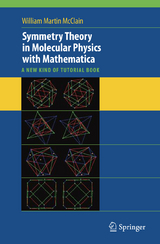Symmetry Theory in Molecular Physics with Mathematica
Springer-Verlag New York Inc.
978-0-387-73469-9 (ISBN)
After a few initial chapters on the basics of Mathematica, the logic of the book is controlled by group theory. It continues to teach Mathematica by example as the need arises, so an important use is always at hand for any new operator that is taught. To many science students, this is a greatly preferred way of learning a new computer language.
The main part of the book follows a strictly logical development that should be acceptable to the most rigorous minded people, while maintaining an engaging style in the spirit of Numerical Recipes by Press, Flannery, Teukolsky, and Vetterling. The essence of this style is to be just a little opinionated about good and bad ways to calculate things, but to give such advice without provoking offense, and always on an objective basis.
After this comes the development of classes and irreducible representations, culminating in a complete proof that for every group the number of classes is equal to the number of representations, so thatall character tables must be square. The proof is motivated throughout by numerical constructions that rouse curiosity, and draw the reader into a rediscovery of Schur’s Lemmas, which thereby become truly interesting results, rather than the mysterious, dry statements often presented. This section culminates in a method for calculating the entire character table of a group. This is especially important for permutation groups that describe flexible molecules, for which are there very few published character tables.
Once the character tables are established, the real meat of physical applications can begin. The author emphasizes that every application has the same structure: (1) The construction of a reducible representation on the basis of some physical property, (2) its separation into irreducible components, and (3) the interpretation in terms of the "symmetry species" so produced. Because Mathematica and the xyz representations are close at hand, the separation into irreducible components can be done quickly.
W.M. McClain started working with Mathematica as soon as it appeared in 1988, bringing over ten years of nearly daily experience with Mathematica to this book. He has written many research papers that use Mathematica and has also used group theory throughout his 20-year research career in nonlinear spectroscopy. He published the first group theoretic analysis of nonlinear tensors in vibronic sprectroscopy, regarded by many as a landmark paper.
A tutorial on notebooks.- A basic tutorial.- The meaning of symmetry.- Axioms of group theory.- Several kinds of groups.- The fundamental theorem.- The multiplication table.- Molecules.- The point groups.- Euler rotation matrices.- Lie#x2019;s axis-angle rotations.- Recognizing matrices.- to the character table.- The operator MakeGroup.- Product groups.- Naming the point groups.- Tabulated representations of groups.- Visualizing groups.- Subgroups.- Lagrange#x2019;s Theorem.- Classes.- Symmetry and quantum mechanics.- Transformation of functions.- Matrix representations of groups.- Similar representations.- The MakeRep operators.- Reducible representations.- The MakeUnitary operator.- Schur#x2019;s reduction.- Schur#x2019;s First Lemma.- Schur#x2019;s Second Lemma.- The Great Orthogonality.- Character orthogonalities.- Reducible rep analysis.- The regular representation.- Projection operators.- Tabulated bases for representations.- Quantum matrix elements.- Constructing SALCs.- Hybridorbitals.- Vibration analysis.- Multiple symmetries.- One-photon selection rules.- Two-photon tensor projections.- Three-photon tensor projections.- Class sums and their products.- Make a character table.
| Zusatzinfo | XV, 689 p. With CD-ROM. |
|---|---|
| Verlagsort | New York, NY |
| Sprache | englisch |
| Maße | 155 x 235 mm |
| Themenwelt | Naturwissenschaften ► Chemie |
| Naturwissenschaften ► Physik / Astronomie ► Atom- / Kern- / Molekularphysik | |
| Naturwissenschaften ► Physik / Astronomie ► Hochenergiephysik / Teilchenphysik | |
| ISBN-10 | 0-387-73469-4 / 0387734694 |
| ISBN-13 | 978-0-387-73469-9 / 9780387734699 |
| Zustand | Neuware |
| Informationen gemäß Produktsicherheitsverordnung (GPSR) | |
| Haben Sie eine Frage zum Produkt? |
aus dem Bereich





